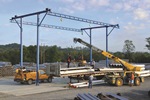
Solving a Truck Loading Challenge
Bristol Metals explored several solutions and found a way to maintain an effective loading process while creating a safer work environment.
- By Kevin Duhamel
- Apr 01, 2013
Mike Vance does not wear a cape to work. He's not from a planet with a red sun, and he's unable to leap buildings in a single bound. He's never considered himself a superhero by any means. Yet, as director of engineering at Bristol Metals in Tennessee, you could call him a Man of Steel. He also bears a superhero's burden, given that his job is to keep people safe.
"We're a manufacturer of stainless steel pipe, and all day we're loading flatbed trucks with multiple stacks of the pipe for shipment," said Vance. "We've been loading trucks at this facility for 50 years, and the risk is certainly there for someone to fall off of the truck while it's being loaded. There have been incidents where people have fallen. Nobody has been seriously injured, but the risk is there."
Having stepped up their safety program in recent years, Vance and his safety team took a proactive look at health and safety risks at the facility and identified the truck loading as the highest safety risk for their employees. Under OSHA's requirements, all workers must have some form of fall protection while on the beds of the trucks. OSHA requires fall protection for employees who work at elevation, defined as 4 feet per the OSHA 1910 standard for general industry and 6 feet per OSHA 1926 construction standards.
The company explored several solutions to maintain an effective loading process while creating a safer work environment.
"We looked into a new building that would have overhead cranes to load the trucks, but that didn't change anything for the workers, who would still need to be tied off. We talked about using man-lifts to reach over and keep the men off the truck, but after studying the situation, it would be very difficult to effectively load unless they can actually be on the truck," Vance said.
Their solution? Two freestanding fall protection systems. These rigid rail fall protection systems cost less than a new building and still allowed their workers to remain on the truck. The primary system features two cantilevered monorails, which enables two flatbeds to be loaded in the same area simultaneously. Each monorail uses dual track, allowing two workers to pass each other safely without disconnecting the lanyard from their harness. A second system featured a single cantilevered monorail, also with the dual track.
This article originally appeared in the April 2013 issue of Occupational Health & Safety.
About the Author
Kevin Duhamel, Gorbel Tether Track™ Product Manager, is a North American product manager with Gorbel Inc. He has more than 15 years of safety industry experience and expertise and has specialized in fall protection since 2008. He is a certified fall protection–competent trainer and inspector.